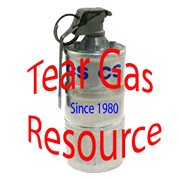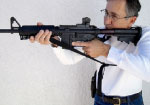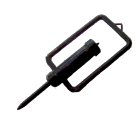There are two areas to consider when contemplating tactics using Non-Lethal Chemical Agents. The realms of use are outdoor and indoor. Each realm has its own unique problems. However, several axioms hold true when using Non-Lethal Chemical Agents either outdoors or indoors.
Before using Non-Lethal Chemical Agents either outdoors or indoors several pieces of information must be gathered. The first is the “wind direction” and the second is the “avenue of escape”.
The wind direction must be determined so that the Non-Lethal Chemical Agent can be channeled, if possible, where it won't  affect innocent or uninvolved citizens. A quick survey of what it will affect downwind needs to be made.
affect innocent or uninvolved citizens. A quick survey of what it will affect downwind needs to be made.
Some of the obstacles that may impede the release of Non-Lethal Chemical Agents could be: hospitals, occupied schools, libraries, nursing homes or any structure that holds uninvolved persons.
The second important piece of information that needs to be gathered is an avenue of escape. An avenue of escape is a route of travel you want for those affected by the Non-Lethal Chemical Agent to use. That avenue of escape must be to an area that the affected person won't get injured if they take it.
Think about where the suspects are going to go. If a barricaded suspect, where will he leave the structure? If an unruly and riotous crowd outdoors you should consider  whether the escape route they take will injure them, or will the route take them to transportation that will allow them to leave the area, or will they just disperse and remain in the area, waiting to regroup and cause you to do it all over again. Consider the escape route during your gas plan!
whether the escape route they take will injure them, or will the route take them to transportation that will allow them to leave the area, or will they just disperse and remain in the area, waiting to regroup and cause you to do it all over again. Consider the escape route during your gas plan!
At every scene that Non-Lethal Chemical Agent is deployed an ambulance or some type of medical aid should be present. If Non-Lethal Chemical Agent is to be used there is inherent danger to the situation. The likelihood of someone getting injured is present. Having medical personnel present will allow for the prompt treatment of the suspect, officers or citizens when injured.
Every scene that pyrotechnic or blast dispersion devices are used a fire truck should be present. At the high burning temperature of pyrotechnic devices and the spark from the ignition of a blast dispersion device in a gaseous environment, the likelihood of fire is present. Having firemen on scene will cut down the chances of a small fire started from the devices from turning into a major conflagration. The fire incident commander should be made a part of your incident command so that the firemen present have an idea of what to expect.
When using Non-Lethal Chemical Agents outdoors the most effective method of delivery is the pyrotechnic or fog method. Both methods produce a visible cloud of agent that is wind directed. It is important to understand how the burning agent cloud responds to the air.
As the agent is produced by either the fog method or pyrotechnic a visible cloud is formed. That cloud spreads laterally and rises. Add Its rate of spread and rising is dependent upon the speed of the wind, humidity, and temperature.
laterally and rises. Add Its rate of spread and rising is dependent upon the speed of the wind, humidity, and temperature.
The angle of the lateral spread is greater with reduced wind and is smaller the higher the wind speed. As shown on the Beaufort wind scale the ideal wind speed is 3-5 mph.
As the agent cloud spreads laterally it also rises. Again the speed of the wind will play a substantial part in the speed with which the cloud will rise. The cloud rises faster in minimum wind and will rise slower in heavy wind. Temperature and humidity plays a part in how fast the cloud will rise. The more humidity the slower the cloud will rise. The heavy air will hold the droplets of vapor closer to the ground. Also a cooler day will hold the cloud down. A warmer day will allow for the vapor to rise faster. The rising will take place as the cloud spreads laterally and blows downwind. Ideally the bottom  edge of the cloud will hug the ground creating a cloud that is hard to escape from. At some point downwind the visible cloud will rise away from the ground. This will allow for persons in this area to escape some of the agent by getting next to the ground.
edge of the cloud will hug the ground creating a cloud that is hard to escape from. At some point downwind the visible cloud will rise away from the ground. This will allow for persons in this area to escape some of the agent by getting next to the ground.
As the agent burns it is in small enough micro pulverized sizes to consider the agent a vapor. Traditionally, the environmental sciences have divided particles into two main groups. These two groups are insert different in many ways. PM10 is particles between 2.5 and 10 microns (micrometers) in diameter (a human hair is about 60 micron in diameter). PM2.5 is particles smaller than 2.5 microns. When device is burning and initially releasing its’ particles of CS they are PM2.5 sized. 
The PM10 and PM2.5 measurements you might have seen reported, by the EPA for example refer to the total weight of the particle found. This is a holdover from when the available technology had difficulty detecting individual particles. More modern monitoring equipment, such as that used in clean room monitoring, count and size individual particles. The Dylos DC1100 is this more modern type of device and counts individual particles in two size ranges which will roughly correlate to PM2.5 and PM10. Most tear gas vapors or visible cloud will be measured as PM10.
The smaller the particle the longer it can remain suspended in the air before settling. PM2.5 can stay in the air from hours to weeks and travel very long distances because it is smaller and lighter. PM10 can stay in the air for minutes to hours and can travel shorter distances from hundreds of yards to many miles because it is larger and heavier.
As the agent is exposed to the air it cools. This cooling makes the small particles combine or attach to one another. As the particles grow they become heavier and eventually fall from the air. Theoretically the cloud downwind as it cools could have very little agent left in it. Many respirators will not filter particles that small. As the agent cools they become larger and allow most law enforcement respirators to filter them.
For an individual to be effected by the tear gas he/she has to have their head in the visible cloud. If one stands next to the cloud and dodges the cloud he/she can stay there until such time as they get their head in the cloud. 
The particulate cloud must have a concentration of at least four milligrams per cubic meter of tear gas to be effective on most rioters. If the rioters are trained in Non-Lethal Chemical Agents the particulate level must be at least ten milligrams per cubic meter of space. This level is not difficult to achieve with most modern pyrotechnic grenade clouds or foggers.
When a crowd is to be dispersed the entire crowd must be  totally enveloped in the agent. Those rioters that are not in the cloud will be unaffected by the agent and will be able to continue their unlawful behavior.
totally enveloped in the agent. Those rioters that are not in the cloud will be unaffected by the agent and will be able to continue their unlawful behavior.
According to the Unites States Environmental Protective Agency, people with heart or lung diseases, older adults and children are most likely to be affected by particle pollution exposure. (Not just CS but all pollutants) However, even if you are healthy, you may feel temporary symptoms if you are exposed to high levels of particle pollution. Numerous scientific studies connect particle pollution exposure to a variety of health issues, including:
- irritation of the eyes, nose and throat
- coughing, chest tightness and shortness of breath
- reduced lung function
- irregular heartbeat
- asthma attacks
- heart attacks
- premature death in people with heart or lung disease
If a law enforcement officer is caught in a riotous crowd without a respirator, he should:
- Move towards the burning agent. This will allow him to get his head out of the cloud the soonest. He should be cautious when approaching a riot line of other law enforcement officers. If he is undercover, he could easily be mistaken for a rioter trying to attack them.
- Move laterally across the agent cloud in order to get out of it. If he tries to run away from it, downwind, he must run faster than the wind is blowing the agent.
- Breathe through his nose and out through his mouth. The hair in his nose will filter some agent. In the case of CS the moisture in his nasal passages will start to break down the agent the fastest.





